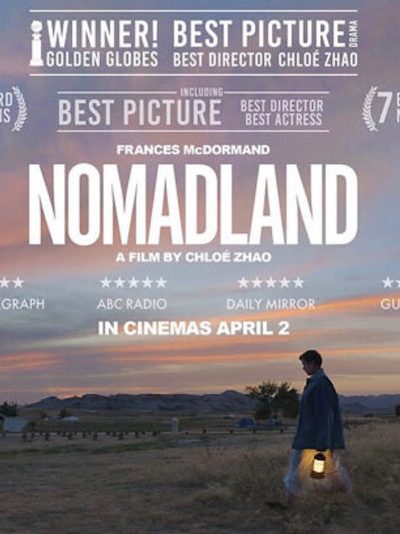Nomadland: A “Chinese” Western
This year’s big Oscar-winner indicates that the U.S. and China are two sides of the same coin.
May 9, 2021

After a 14-month-long hiatus, I went to the cinema last week for the first time since COVID went viral. I watched Nomadland. It was an obvious choice, given its recent haul of six Oscars, including those for Best Picture, Director and Actress.
Cinematic ballad
As expected from the reviews, it was a cinematic ballad: quietly powerful, elegiac. A rambling, almost documentary-like look at the United States’ modern nomads.
These are people who live in camper vans. They work as daily wagers in an assortment of physically demanding jobs. They migrate like elks with the weather and their mood.
A contemporary Western
It was also, as expected, deeply rooted in mid-western America. The landscape is an actor in the movie as much as Frances McDormand.
And the film is an iteration of a long-established American tradition of movie making. Critics have called it a Western for contemporary times.
Surprisingly Chinese
So, what surprised me most, was how through the movie-watching experience I caught myself repeatedly thinking what a Chinese movie it was.
This wasn’t because the director, Chloe Zhao, is Chinese-born, although her awareness of Chinese cinema has no doubt been an influence on Nomadland. It was because the subject matter, so American, was at once so Chinese.
Nomadland begins and ends in a ghost-town, Empire, Nevada. Empire is an abandoned company town in its death throws, following the closing down of a gypsum mining plant, its economic lifeline.
Sixth generation film makers
The movie immediately put me in mind of the films of China’s so-called “sixth generation” of film makers.
As a group they are known for their low-budget, individualistic, documentary-style films on contemporary urban life and the disorientating effects on workers as the state gives way to market forces.
The best known of these film makers is Jia Zhangke, who is somewhat of a darling of the international film circuit, His 2006, Still Life, won the Venice Film Festival’s top award, the Golden Lion.
Chengdu vs Nevada
Still Life was set in a town about to be flooded by construction of the Three Gorges Dam. It shares the themes of physical and emotional loss with Nomadland, including inexorable change in the name of economic development.
In another Jia movie, 24-city, the lens is focused on displaced workers in the southwestern Chinese city of Chengdu. In this 2008 movie, a state-owned munitions factory gives way to a real estate development.
Nevada and Chengdu might seem poles apart. But, Nomadland and 24-city demonstrate how people in both these far-flung parts of the world experience visceral abandonment in the face of being made redundant, not only from their jobs, but even as people.
Matching temperaments
Watching the movie also put me in mind of how I have long believed that the Chinese and Americans share more in temperament than the standard received wisdom would have it.
Geo-strategic punditry tends to focus on China-U.S. rivalry framed as irreconcilable differences: the individualistic vs the communitarian; the liberal market-economy vs state-led capitalism.
Different operating systems?
I recently read an article that claimed that the American and Chinese systems were “like computers running on different operating systems.”
However, as someone who has lived in both countries, what always struck me most was their similarities.
Chinese: Americans of Asia
The Chinese, I have argued since first living in Beijing between 2002 and 2009 are the Americans of Asia. (In contrast, the Indians are Europeans of Asia, as I will explain in another essay.)
As players on the international stage, the United States and China are both goal-oriented and able to act decisively in their national interest.
Despite the existence of internal divisions they are coherent entities that speak with a unified voice. Backed by hard power, their strategic planners take a long-term view of evolving rivalries and alliances.
Two sides of the same coin
Ultimately, Nomadland and many of the movies of China’s sixth generation explore two side of the same phenomenon: economic globalization.
The scenes in Nomadland of casual workers moving from assembly line to assembly line could have been substituted with migrant workers in China working for many of the same factory brands. Amazon, which is prominently featured in Nomadland, for example.
Nomads and migrants
The closure of factories in the United States and the legions of migrants in China who have left their villages to become factory workers in the country’s growing urban sprawls are part of the same economic mechanism that binds the U.S and China in a consumerist grip.
The new American nomads of Nomadland are described, both by a character in the movie itself, and by several critics, as a modern avatar of the American pioneers, making their individualistic way through the rugged wild of the West.
To me, they seemed closer to economically better-off versions of China’s migrant workers.
Conclusion
Nomadland’s protagonists, their faces all weathered lines and set lips, walk a tightrope between being masters of their own destiny and victims of circumstances outside their control.
They focus so much on the present because the future is unpredictable. There could be few better summaries of contemporary lives in China.
Takeaways
Curious thing in these times of #SinoAmerican strife: This year’s big #Oscar winner, #Nomadland, is as Chinese in subject matter as it is American.
#Nomadland’s theme of physical and emotional loss under the yoke of economic progress is an experience shared by both #Chinese and #American people.
Casual workers, moving from assembly line to assembly line, are like #migrantworkers in #China. And they work for many of the same factory brands.
The Chinese and Americans share more in temperament than most people realize, including #XiJinping and #JoeBiden: The Chinese are, in fact, the Americans of Asia.
As the top players on the international stage, the #US and #China are both goal-oriented and able to act decisively in their national interest.
Many of #China’s “sixth generation” filmmakers explore two sides of the same phenomenon: economic globalization.

